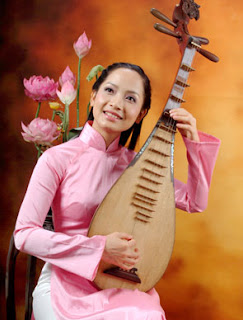One
of only two purely Vietnamese instruments, the dan bau consists of a hardwood
frame and a softwood surface, over which a string is stretched and connected to
a handle decorated with dried gourd (bau).
“Do
not listen to the music of the dan bau if you are a young woman.”
Such
is the romantic and emotional appeal of music played on the dan bau that
Vietnamese parents used to warn their daughters against listening to it. For
the rest of us, it remains the quintessential sound of Vietnam.
One
of only two purely Vietnamese instruments, the dan bau consists of a hardwood
frame and a softwood surface, over which a string is stretched and connected to
a handle decorated with dried gourd (bau). The first dan bau is believed to
have been made in 1770, a simple instrument consisting of a bamboo section, a
flexible rod, and a half coconut. Since then it has evolved to become the
instrument we know today.
The
string, made of iron, is tuned using a bamboo tuning peg and played with the
right hand using a pick made of bamboo or rattan. The pitch is varied by
pressing, releasing, holding or vibrating the string with the left hand.
The
dan bau is usually played solo or to accompany poetry recitals, though in
recent years it has been added to the orchestral accompaniment to cheo and cai
luong opera. Amplified dan bau are now more common, enabling the player to play
to larger audiences while losing nothing in sound quality.































